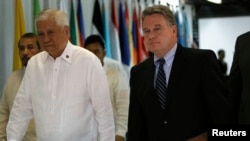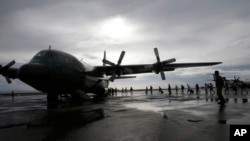MANILA —
Philippines officials say the challenges of mounting the relief effort for Typhoon Haiyan show the urgency of signing a long-term agreement on an increased U.S. troop presence in the country. Typhoon Haiyan struck as the United States and the Philippines were negotiating a plan for more regular U.S. troop rotations to the country.
The negotiators have been meeting for months, but Philippine representatives have said they still need time to study some issues.
On Monday, Philippine Foreign Affairs Secretary Albert del Rosario made a pitch for finalizing the agreement at a briefing with a U.S. Congressional delegation in Manila.
“I think this [disaster] demonstrates the need for this framework agreement that we’re working out with the United States… because it accentuates one of the main purposes of the framework, which is to make humanitarian and disaster relief and response a major aspect of the agreement,” said del Rosario.
Haiyan crippled the central provinces’ infrastructure when its powerful winds knocked out electricity and downed communications towers. It wiped out most of the houses in villages and municipalities and left a tangled mess of trees and debris clogging roads for days.
The devastation hampered the aid effort and handicapped the Philippines military's ability to respond. The U.S. sent some 50 ships and aircraft to the region for a humanitarian assistance and disaster relief (HADR) operation. U.S. forces also helped work out logistics for the Philippines' own response.
Relief operations in the Philippines
Closer partnership
Arizona Congressman Trent Franks told reporters in Manila the U.S. is committed to solidifying the mutual defense partnership.
“I think it’s vitally important for us to stick together and take every opportunity we have, including this one, to try to bring our military efforts close together,” he said.
Carl Baker, program director at the Pacific Forum of the Washington-based Center for Strategic and International Studies, says the Haiyan relief operation will influence negotiations between the two countries, but it should not be a determining factor for the agreement.
“I think it would be a mistake for the United States to go into those [negotiations] thinking that now it has additional leverage to convince the Philippines to accept terms that it wasn’t prepared to accept,” he said.
Many countries and organizations are providing humanitarian aid to the Philippines in the wake of Friday's typhoon. The most prominent donors include:
The Philippines, which has one of the smallest military budgets in the region, wants the increased U.S. troop presence to complement its military expansion plans. It is particularly concerned with a contentious territorial dispute with China over islets in the resource-rich South China Sea. At the same time, the U.S. is shifting its security and economic focus to Asia, where China’s influence continues to grow.
Philippines Armed Forces Chief of Staff General Emmanuel Bautista says the U.S. disaster response has helped strengthen the Philippine military.
“Among the other crisis we’ve faced in the past and also this one, they have always been with us, demonstrated their willingness and their capability to assist us in any problem that we face,” he said.
The China factor
Institute of Southeast Asian Studies Fellow Ian Storey says the U.S. typhoon response has helped the two countries get closer to their objectives.
“The United States doesn’t want to say ‘We want to increase our military presence in the Philippines because of China.’ They will use other reasons as well, like a HADR as one of the widely important factors that they will use to strengthen their case,” he said.
Last week, China offered its 14,000 ton floating military hospital, called the Peace Ark toward Haiyan relief efforts. Storey says this is a significant move because it would be the Peace Ark’s first humanitarian response operation.
The negotiators have been meeting for months, but Philippine representatives have said they still need time to study some issues.
On Monday, Philippine Foreign Affairs Secretary Albert del Rosario made a pitch for finalizing the agreement at a briefing with a U.S. Congressional delegation in Manila.
“I think this [disaster] demonstrates the need for this framework agreement that we’re working out with the United States… because it accentuates one of the main purposes of the framework, which is to make humanitarian and disaster relief and response a major aspect of the agreement,” said del Rosario.
Haiyan crippled the central provinces’ infrastructure when its powerful winds knocked out electricity and downed communications towers. It wiped out most of the houses in villages and municipalities and left a tangled mess of trees and debris clogging roads for days.
The devastation hampered the aid effort and handicapped the Philippines military's ability to respond. The U.S. sent some 50 ships and aircraft to the region for a humanitarian assistance and disaster relief (HADR) operation. U.S. forces also helped work out logistics for the Philippines' own response.
Relief operations in the Philippines
Closer partnership
Arizona Congressman Trent Franks told reporters in Manila the U.S. is committed to solidifying the mutual defense partnership.
“I think it’s vitally important for us to stick together and take every opportunity we have, including this one, to try to bring our military efforts close together,” he said.
Carl Baker, program director at the Pacific Forum of the Washington-based Center for Strategic and International Studies, says the Haiyan relief operation will influence negotiations between the two countries, but it should not be a determining factor for the agreement.
“I think it would be a mistake for the United States to go into those [negotiations] thinking that now it has additional leverage to convince the Philippines to accept terms that it wasn’t prepared to accept,” he said.
Philippine Aid Donors Factbox
Philippine Aid Donors FactboxMany countries and organizations are providing humanitarian aid to the Philippines in the wake of Friday's typhoon. The most prominent donors include:
- UNITED NATIONS: $25 million released from U.N. emergency relief fund, appealing for more
- UNITED STATES: $20 million in aid, plus military assistance
- EU: $17 million
- BRITAIN: $16 million, plus military assistance
- JAPAN: $10 million, and an emergency medical relief team
- UNITED ARAB EMIRATES: $10 million
- AUSTRALIA: $9.3 million, including medical personnel
- SOUTH KOREA: $5 million, plus a disaster relief team
- CANADA: up to $5 million
- U.N. WORLD FOOD PROGRAM: $2 million
- NEW ZEALAND: $1.7 million
- U.N. CHILDREN'S FUND (UNICEF): $1.3 million worth of supplies
- HSBC (global banking group): $1 million
- SAMSUNG (South Korean technology company): $1 million
- TAIWAN: $200,000
- VATICAN: $150,000 in initial assistance
- CHINA: $100,000
- CHINA RED CROSS: $100,000
Philippines Armed Forces Chief of Staff General Emmanuel Bautista says the U.S. disaster response has helped strengthen the Philippine military.
“Among the other crisis we’ve faced in the past and also this one, they have always been with us, demonstrated their willingness and their capability to assist us in any problem that we face,” he said.
The China factor
Institute of Southeast Asian Studies Fellow Ian Storey says the U.S. typhoon response has helped the two countries get closer to their objectives.
“The United States doesn’t want to say ‘We want to increase our military presence in the Philippines because of China.’ They will use other reasons as well, like a HADR as one of the widely important factors that they will use to strengthen their case,” he said.
Last week, China offered its 14,000 ton floating military hospital, called the Peace Ark toward Haiyan relief efforts. Storey says this is a significant move because it would be the Peace Ark’s first humanitarian response operation.












